Hospitality: History, Politics, and Culture - Course Assignment
VerifiedAdded on 2020/02/24
|9
|2085
|92
Essay
AI Summary
This essay provides a comprehensive analysis of hospitality, exploring its historical, political, and cultural dimensions. It examines the evolution of commercial hospitality from its ancient roots to modern practices, contrasting it with hospitality in the home. The essay highlights the key differences and similarities between these domains, focusing on the guest-host relationship, the role of monetary exchange, and the influence of social and cultural values. It argues that while commercial hospitality has its own distinct domain, it is influenced by the values and expectations shaped by domestic hospitality. The essay also discusses the concept of a 'home away from home' in commercial settings, such as hotels, and how these establishments strive to create positive guest experiences. Ultimately, the essay concludes that commercial hospitality, though distinct, is not merely an extension of hospitality in the home but operates within its own sphere, influenced by the integration of social, commercial and private domains.
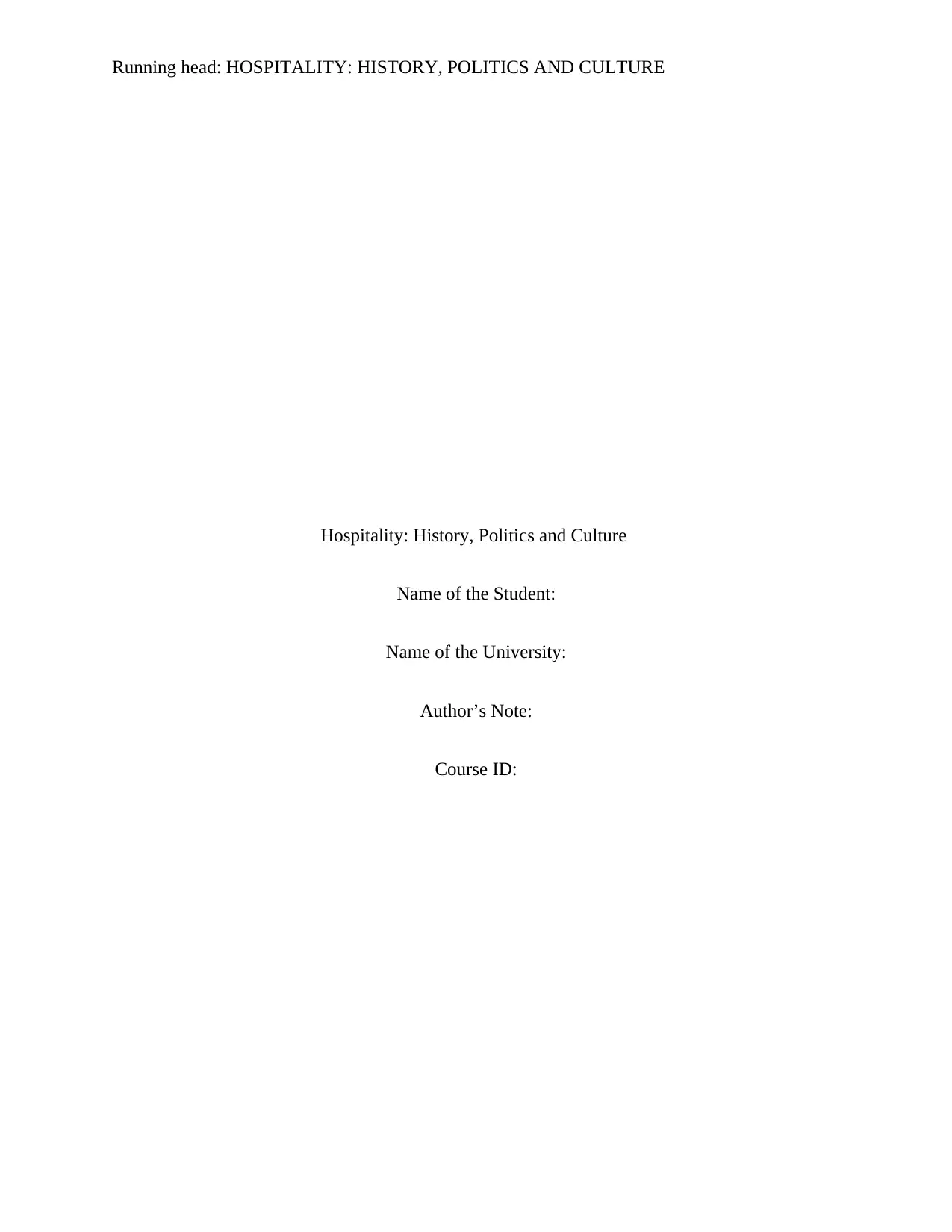
Running head: HOSPITALITY: HISTORY, POLITICS AND CULTURE
Hospitality: History, Politics and Culture
Name of the Student:
Name of the University:
Author’s Note:
Course ID:
Hospitality: History, Politics and Culture
Name of the Student:
Name of the University:
Author’s Note:
Course ID:
Paraphrase This Document
Need a fresh take? Get an instant paraphrase of this document with our AI Paraphraser
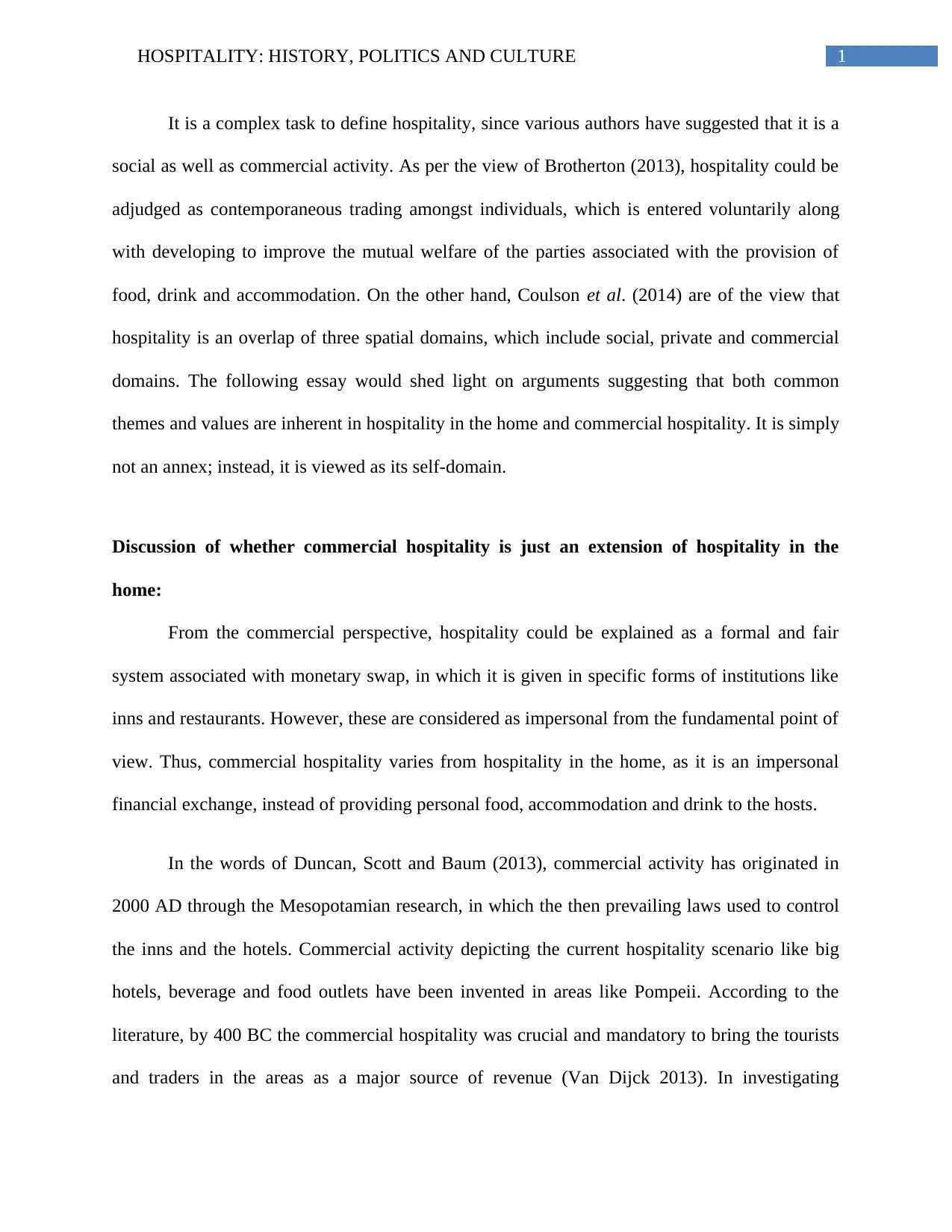
1HOSPITALITY: HISTORY, POLITICS AND CULTURE
It is a complex task to define hospitality, since various authors have suggested that it is a
social as well as commercial activity. As per the view of Brotherton (2013), hospitality could be
adjudged as contemporaneous trading amongst individuals, which is entered voluntarily along
with developing to improve the mutual welfare of the parties associated with the provision of
food, drink and accommodation. On the other hand, Coulson et al. (2014) are of the view that
hospitality is an overlap of three spatial domains, which include social, private and commercial
domains. The following essay would shed light on arguments suggesting that both common
themes and values are inherent in hospitality in the home and commercial hospitality. It is simply
not an annex; instead, it is viewed as its self-domain.
Discussion of whether commercial hospitality is just an extension of hospitality in the
home:
From the commercial perspective, hospitality could be explained as a formal and fair
system associated with monetary swap, in which it is given in specific forms of institutions like
inns and restaurants. However, these are considered as impersonal from the fundamental point of
view. Thus, commercial hospitality varies from hospitality in the home, as it is an impersonal
financial exchange, instead of providing personal food, accommodation and drink to the hosts.
In the words of Duncan, Scott and Baum (2013), commercial activity has originated in
2000 AD through the Mesopotamian research, in which the then prevailing laws used to control
the inns and the hotels. Commercial activity depicting the current hospitality scenario like big
hotels, beverage and food outlets have been invented in areas like Pompeii. According to the
literature, by 400 BC the commercial hospitality was crucial and mandatory to bring the tourists
and traders in the areas as a major source of revenue (Van Dijck 2013). In investigating
It is a complex task to define hospitality, since various authors have suggested that it is a
social as well as commercial activity. As per the view of Brotherton (2013), hospitality could be
adjudged as contemporaneous trading amongst individuals, which is entered voluntarily along
with developing to improve the mutual welfare of the parties associated with the provision of
food, drink and accommodation. On the other hand, Coulson et al. (2014) are of the view that
hospitality is an overlap of three spatial domains, which include social, private and commercial
domains. The following essay would shed light on arguments suggesting that both common
themes and values are inherent in hospitality in the home and commercial hospitality. It is simply
not an annex; instead, it is viewed as its self-domain.
Discussion of whether commercial hospitality is just an extension of hospitality in the
home:
From the commercial perspective, hospitality could be explained as a formal and fair
system associated with monetary swap, in which it is given in specific forms of institutions like
inns and restaurants. However, these are considered as impersonal from the fundamental point of
view. Thus, commercial hospitality varies from hospitality in the home, as it is an impersonal
financial exchange, instead of providing personal food, accommodation and drink to the hosts.
In the words of Duncan, Scott and Baum (2013), commercial activity has originated in
2000 AD through the Mesopotamian research, in which the then prevailing laws used to control
the inns and the hotels. Commercial activity depicting the current hospitality scenario like big
hotels, beverage and food outlets have been invented in areas like Pompeii. According to the
literature, by 400 BC the commercial hospitality was crucial and mandatory to bring the tourists
and traders in the areas as a major source of revenue (Van Dijck 2013). In investigating
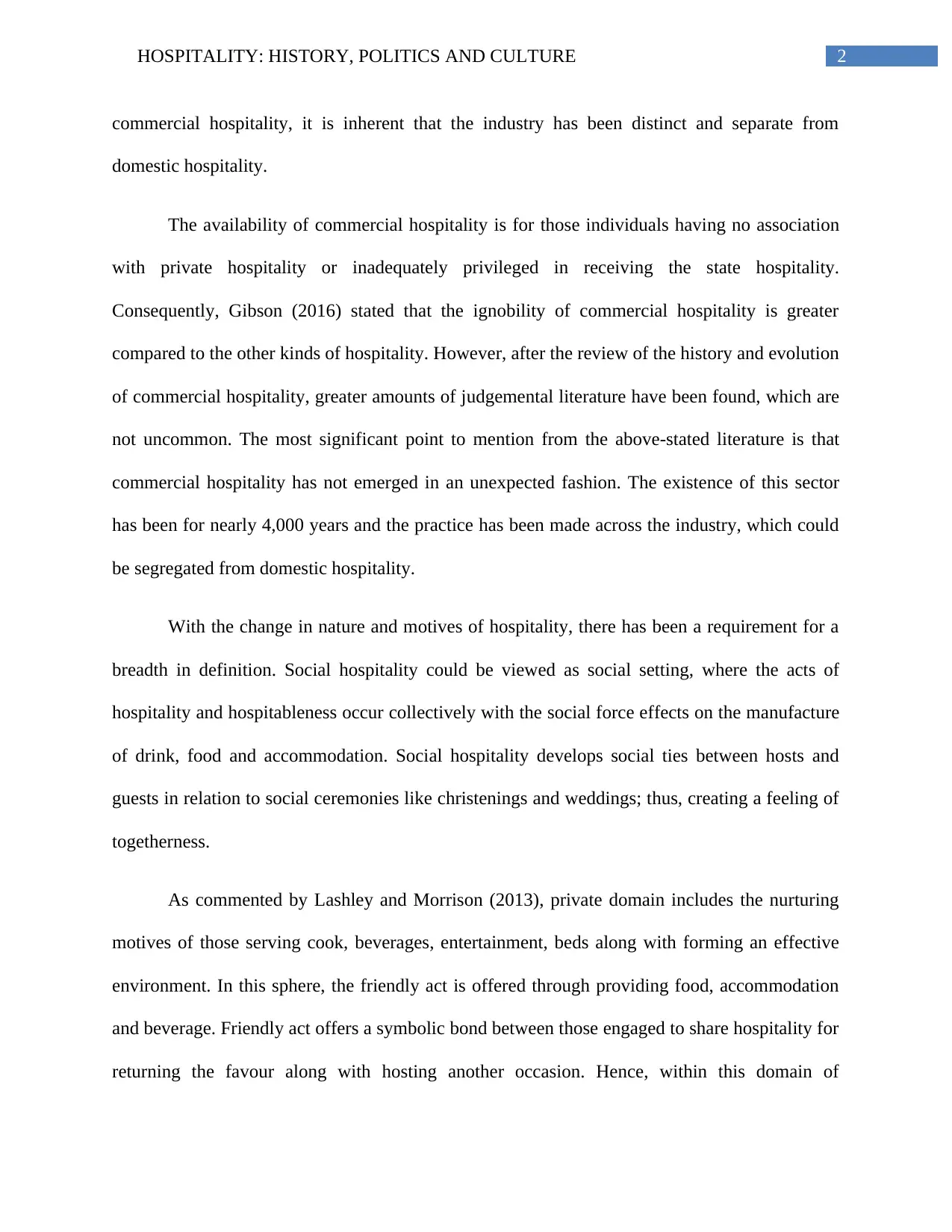
2HOSPITALITY: HISTORY, POLITICS AND CULTURE
commercial hospitality, it is inherent that the industry has been distinct and separate from
domestic hospitality.
The availability of commercial hospitality is for those individuals having no association
with private hospitality or inadequately privileged in receiving the state hospitality.
Consequently, Gibson (2016) stated that the ignobility of commercial hospitality is greater
compared to the other kinds of hospitality. However, after the review of the history and evolution
of commercial hospitality, greater amounts of judgemental literature have been found, which are
not uncommon. The most significant point to mention from the above-stated literature is that
commercial hospitality has not emerged in an unexpected fashion. The existence of this sector
has been for nearly 4,000 years and the practice has been made across the industry, which could
be segregated from domestic hospitality.
With the change in nature and motives of hospitality, there has been a requirement for a
breadth in definition. Social hospitality could be viewed as social setting, where the acts of
hospitality and hospitableness occur collectively with the social force effects on the manufacture
of drink, food and accommodation. Social hospitality develops social ties between hosts and
guests in relation to social ceremonies like christenings and weddings; thus, creating a feeling of
togetherness.
As commented by Lashley and Morrison (2013), private domain includes the nurturing
motives of those serving cook, beverages, entertainment, beds along with forming an effective
environment. In this sphere, the friendly act is offered through providing food, accommodation
and beverage. Friendly act offers a symbolic bond between those engaged to share hospitality for
returning the favour along with hosting another occasion. Hence, within this domain of
commercial hospitality, it is inherent that the industry has been distinct and separate from
domestic hospitality.
The availability of commercial hospitality is for those individuals having no association
with private hospitality or inadequately privileged in receiving the state hospitality.
Consequently, Gibson (2016) stated that the ignobility of commercial hospitality is greater
compared to the other kinds of hospitality. However, after the review of the history and evolution
of commercial hospitality, greater amounts of judgemental literature have been found, which are
not uncommon. The most significant point to mention from the above-stated literature is that
commercial hospitality has not emerged in an unexpected fashion. The existence of this sector
has been for nearly 4,000 years and the practice has been made across the industry, which could
be segregated from domestic hospitality.
With the change in nature and motives of hospitality, there has been a requirement for a
breadth in definition. Social hospitality could be viewed as social setting, where the acts of
hospitality and hospitableness occur collectively with the social force effects on the manufacture
of drink, food and accommodation. Social hospitality develops social ties between hosts and
guests in relation to social ceremonies like christenings and weddings; thus, creating a feeling of
togetherness.
As commented by Lashley and Morrison (2013), private domain includes the nurturing
motives of those serving cook, beverages, entertainment, beds along with forming an effective
environment. In this sphere, the friendly act is offered through providing food, accommodation
and beverage. Friendly act offers a symbolic bond between those engaged to share hospitality for
returning the favour along with hosting another occasion. Hence, within this domain of
⊘ This is a preview!⊘
Do you want full access?
Subscribe today to unlock all pages.

Trusted by 1+ million students worldwide
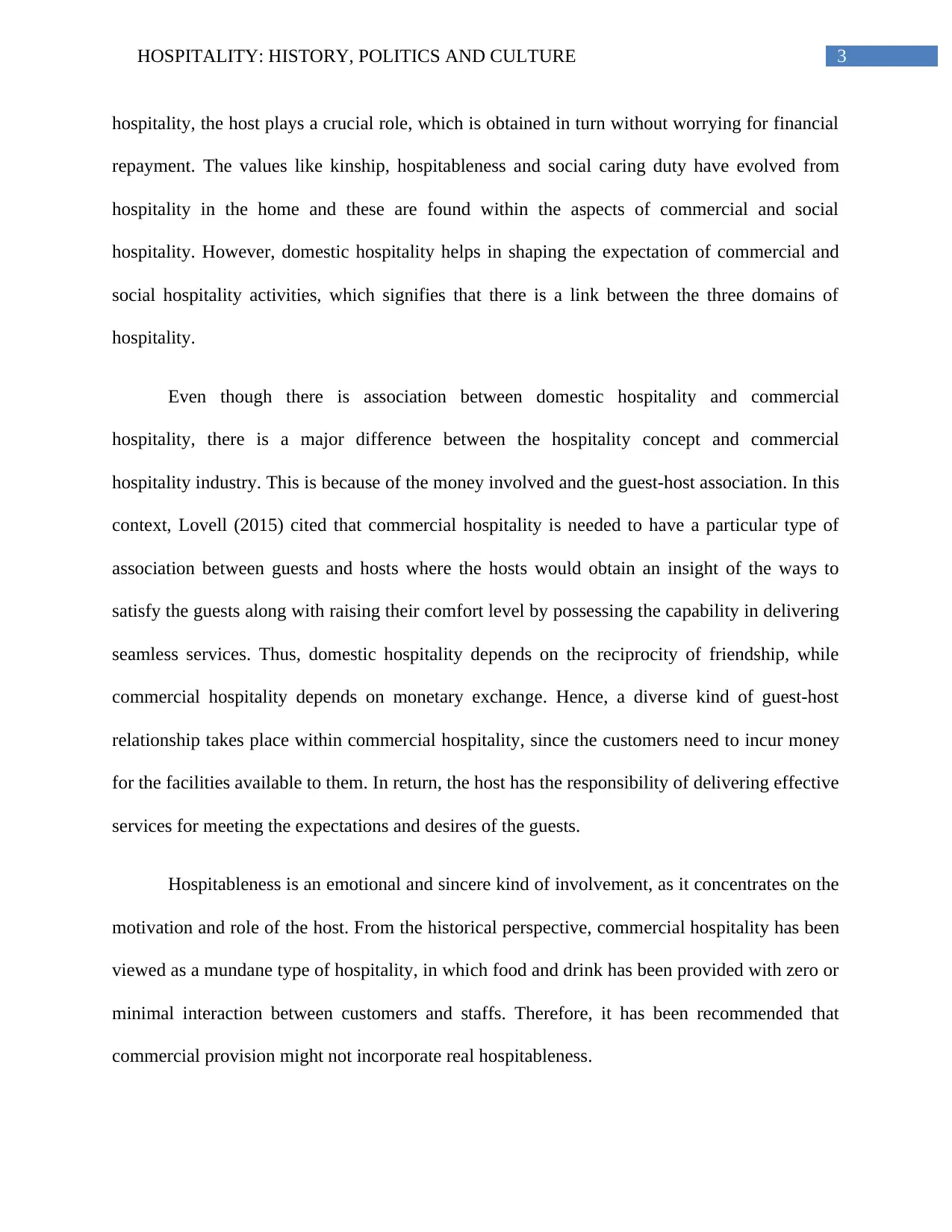
3HOSPITALITY: HISTORY, POLITICS AND CULTURE
hospitality, the host plays a crucial role, which is obtained in turn without worrying for financial
repayment. The values like kinship, hospitableness and social caring duty have evolved from
hospitality in the home and these are found within the aspects of commercial and social
hospitality. However, domestic hospitality helps in shaping the expectation of commercial and
social hospitality activities, which signifies that there is a link between the three domains of
hospitality.
Even though there is association between domestic hospitality and commercial
hospitality, there is a major difference between the hospitality concept and commercial
hospitality industry. This is because of the money involved and the guest-host association. In this
context, Lovell (2015) cited that commercial hospitality is needed to have a particular type of
association between guests and hosts where the hosts would obtain an insight of the ways to
satisfy the guests along with raising their comfort level by possessing the capability in delivering
seamless services. Thus, domestic hospitality depends on the reciprocity of friendship, while
commercial hospitality depends on monetary exchange. Hence, a diverse kind of guest-host
relationship takes place within commercial hospitality, since the customers need to incur money
for the facilities available to them. In return, the host has the responsibility of delivering effective
services for meeting the expectations and desires of the guests.
Hospitableness is an emotional and sincere kind of involvement, as it concentrates on the
motivation and role of the host. From the historical perspective, commercial hospitality has been
viewed as a mundane type of hospitality, in which food and drink has been provided with zero or
minimal interaction between customers and staffs. Therefore, it has been recommended that
commercial provision might not incorporate real hospitableness.
hospitality, the host plays a crucial role, which is obtained in turn without worrying for financial
repayment. The values like kinship, hospitableness and social caring duty have evolved from
hospitality in the home and these are found within the aspects of commercial and social
hospitality. However, domestic hospitality helps in shaping the expectation of commercial and
social hospitality activities, which signifies that there is a link between the three domains of
hospitality.
Even though there is association between domestic hospitality and commercial
hospitality, there is a major difference between the hospitality concept and commercial
hospitality industry. This is because of the money involved and the guest-host association. In this
context, Lovell (2015) cited that commercial hospitality is needed to have a particular type of
association between guests and hosts where the hosts would obtain an insight of the ways to
satisfy the guests along with raising their comfort level by possessing the capability in delivering
seamless services. Thus, domestic hospitality depends on the reciprocity of friendship, while
commercial hospitality depends on monetary exchange. Hence, a diverse kind of guest-host
relationship takes place within commercial hospitality, since the customers need to incur money
for the facilities available to them. In return, the host has the responsibility of delivering effective
services for meeting the expectations and desires of the guests.
Hospitableness is an emotional and sincere kind of involvement, as it concentrates on the
motivation and role of the host. From the historical perspective, commercial hospitality has been
viewed as a mundane type of hospitality, in which food and drink has been provided with zero or
minimal interaction between customers and staffs. Therefore, it has been recommended that
commercial provision might not incorporate real hospitableness.
Paraphrase This Document
Need a fresh take? Get an instant paraphrase of this document with our AI Paraphraser
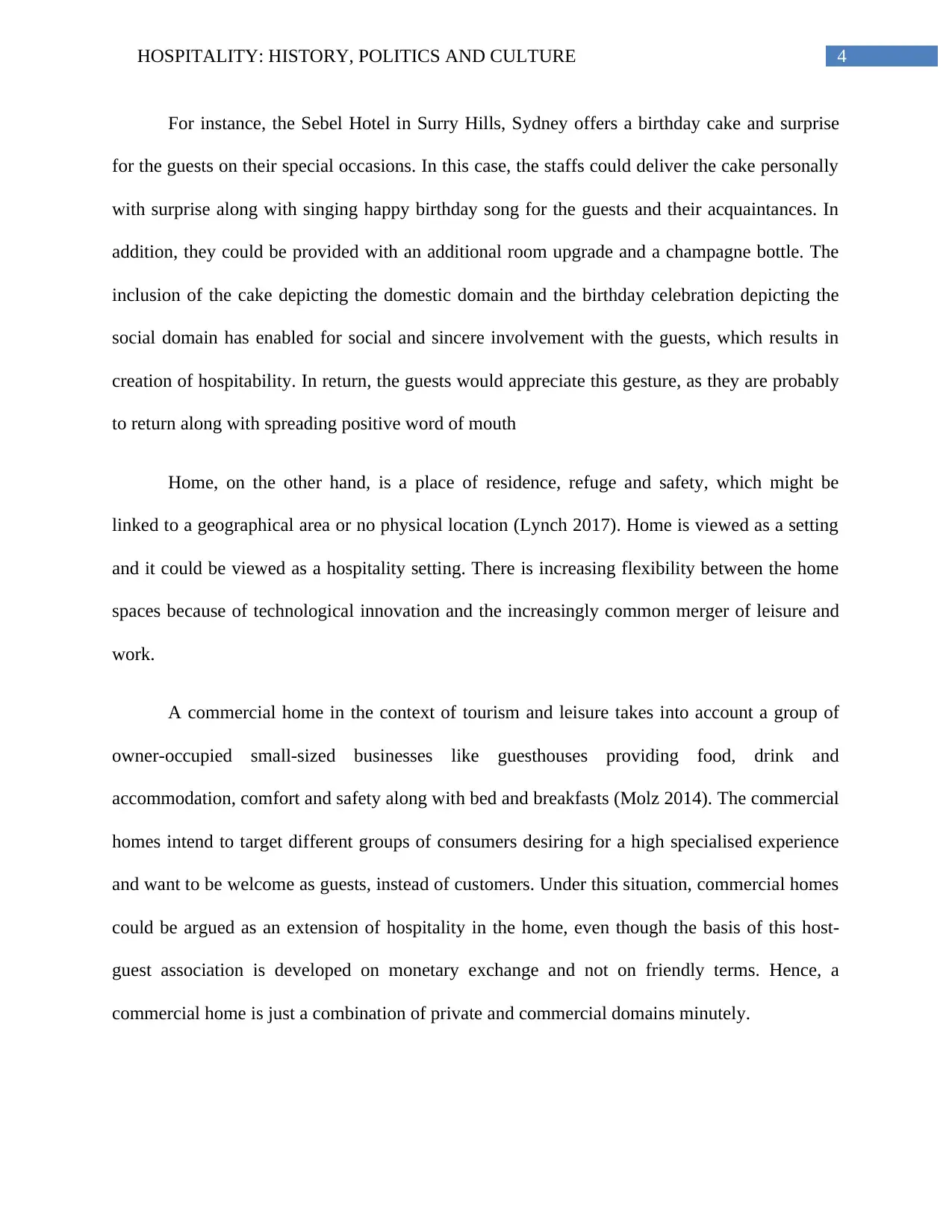
4HOSPITALITY: HISTORY, POLITICS AND CULTURE
For instance, the Sebel Hotel in Surry Hills, Sydney offers a birthday cake and surprise
for the guests on their special occasions. In this case, the staffs could deliver the cake personally
with surprise along with singing happy birthday song for the guests and their acquaintances. In
addition, they could be provided with an additional room upgrade and a champagne bottle. The
inclusion of the cake depicting the domestic domain and the birthday celebration depicting the
social domain has enabled for social and sincere involvement with the guests, which results in
creation of hospitability. In return, the guests would appreciate this gesture, as they are probably
to return along with spreading positive word of mouth
Home, on the other hand, is a place of residence, refuge and safety, which might be
linked to a geographical area or no physical location (Lynch 2017). Home is viewed as a setting
and it could be viewed as a hospitality setting. There is increasing flexibility between the home
spaces because of technological innovation and the increasingly common merger of leisure and
work.
A commercial home in the context of tourism and leisure takes into account a group of
owner-occupied small-sized businesses like guesthouses providing food, drink and
accommodation, comfort and safety along with bed and breakfasts (Molz 2014). The commercial
homes intend to target different groups of consumers desiring for a high specialised experience
and want to be welcome as guests, instead of customers. Under this situation, commercial homes
could be argued as an extension of hospitality in the home, even though the basis of this host-
guest association is developed on monetary exchange and not on friendly terms. Hence, a
commercial home is just a combination of private and commercial domains minutely.
For instance, the Sebel Hotel in Surry Hills, Sydney offers a birthday cake and surprise
for the guests on their special occasions. In this case, the staffs could deliver the cake personally
with surprise along with singing happy birthday song for the guests and their acquaintances. In
addition, they could be provided with an additional room upgrade and a champagne bottle. The
inclusion of the cake depicting the domestic domain and the birthday celebration depicting the
social domain has enabled for social and sincere involvement with the guests, which results in
creation of hospitability. In return, the guests would appreciate this gesture, as they are probably
to return along with spreading positive word of mouth
Home, on the other hand, is a place of residence, refuge and safety, which might be
linked to a geographical area or no physical location (Lynch 2017). Home is viewed as a setting
and it could be viewed as a hospitality setting. There is increasing flexibility between the home
spaces because of technological innovation and the increasingly common merger of leisure and
work.
A commercial home in the context of tourism and leisure takes into account a group of
owner-occupied small-sized businesses like guesthouses providing food, drink and
accommodation, comfort and safety along with bed and breakfasts (Molz 2014). The commercial
homes intend to target different groups of consumers desiring for a high specialised experience
and want to be welcome as guests, instead of customers. Under this situation, commercial homes
could be argued as an extension of hospitality in the home, even though the basis of this host-
guest association is developed on monetary exchange and not on friendly terms. Hence, a
commercial home is just a combination of private and commercial domains minutely.
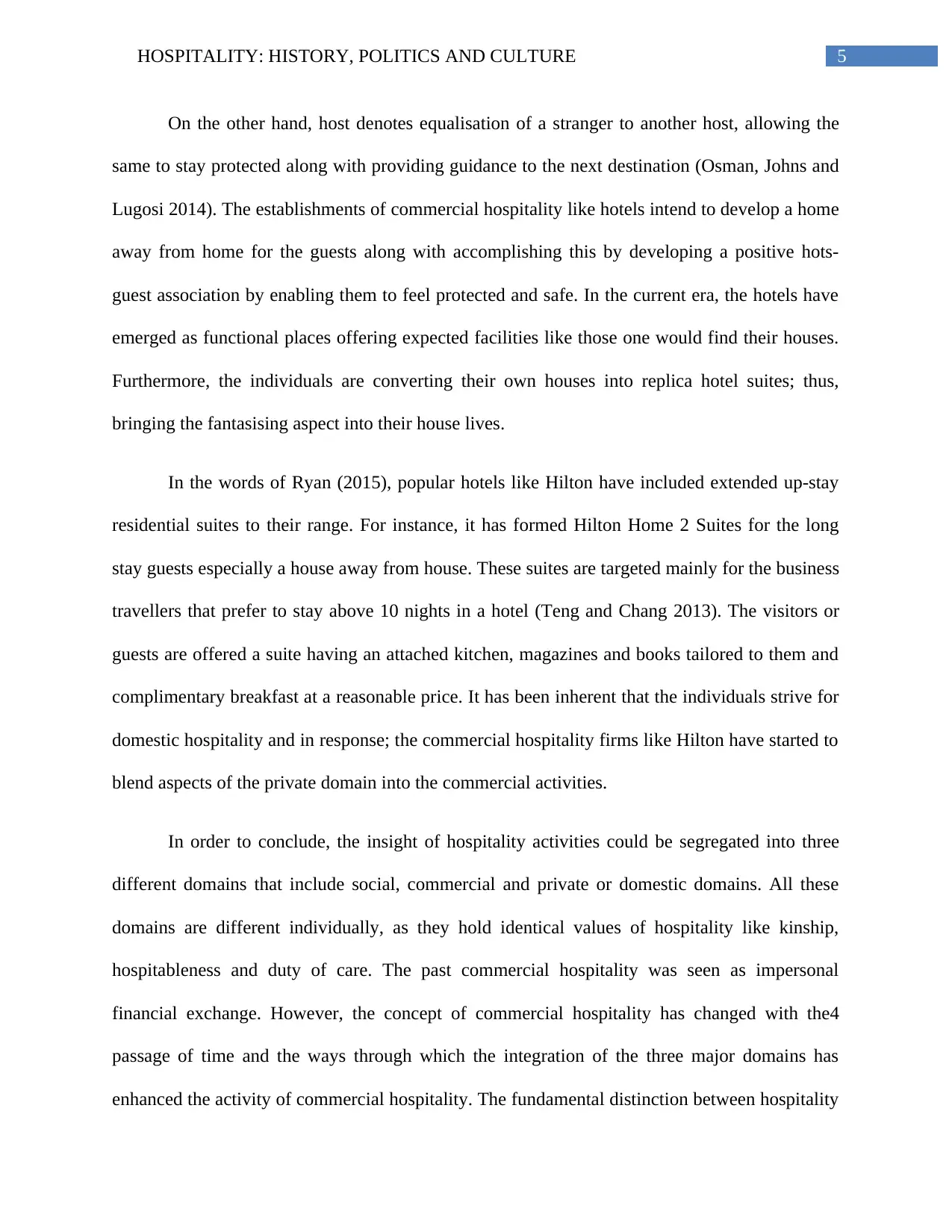
5HOSPITALITY: HISTORY, POLITICS AND CULTURE
On the other hand, host denotes equalisation of a stranger to another host, allowing the
same to stay protected along with providing guidance to the next destination (Osman, Johns and
Lugosi 2014). The establishments of commercial hospitality like hotels intend to develop a home
away from home for the guests along with accomplishing this by developing a positive hots-
guest association by enabling them to feel protected and safe. In the current era, the hotels have
emerged as functional places offering expected facilities like those one would find their houses.
Furthermore, the individuals are converting their own houses into replica hotel suites; thus,
bringing the fantasising aspect into their house lives.
In the words of Ryan (2015), popular hotels like Hilton have included extended up-stay
residential suites to their range. For instance, it has formed Hilton Home 2 Suites for the long
stay guests especially a house away from house. These suites are targeted mainly for the business
travellers that prefer to stay above 10 nights in a hotel (Teng and Chang 2013). The visitors or
guests are offered a suite having an attached kitchen, magazines and books tailored to them and
complimentary breakfast at a reasonable price. It has been inherent that the individuals strive for
domestic hospitality and in response; the commercial hospitality firms like Hilton have started to
blend aspects of the private domain into the commercial activities.
In order to conclude, the insight of hospitality activities could be segregated into three
different domains that include social, commercial and private or domestic domains. All these
domains are different individually, as they hold identical values of hospitality like kinship,
hospitableness and duty of care. The past commercial hospitality was seen as impersonal
financial exchange. However, the concept of commercial hospitality has changed with the4
passage of time and the ways through which the integration of the three major domains has
enhanced the activity of commercial hospitality. The fundamental distinction between hospitality
On the other hand, host denotes equalisation of a stranger to another host, allowing the
same to stay protected along with providing guidance to the next destination (Osman, Johns and
Lugosi 2014). The establishments of commercial hospitality like hotels intend to develop a home
away from home for the guests along with accomplishing this by developing a positive hots-
guest association by enabling them to feel protected and safe. In the current era, the hotels have
emerged as functional places offering expected facilities like those one would find their houses.
Furthermore, the individuals are converting their own houses into replica hotel suites; thus,
bringing the fantasising aspect into their house lives.
In the words of Ryan (2015), popular hotels like Hilton have included extended up-stay
residential suites to their range. For instance, it has formed Hilton Home 2 Suites for the long
stay guests especially a house away from house. These suites are targeted mainly for the business
travellers that prefer to stay above 10 nights in a hotel (Teng and Chang 2013). The visitors or
guests are offered a suite having an attached kitchen, magazines and books tailored to them and
complimentary breakfast at a reasonable price. It has been inherent that the individuals strive for
domestic hospitality and in response; the commercial hospitality firms like Hilton have started to
blend aspects of the private domain into the commercial activities.
In order to conclude, the insight of hospitality activities could be segregated into three
different domains that include social, commercial and private or domestic domains. All these
domains are different individually, as they hold identical values of hospitality like kinship,
hospitableness and duty of care. The past commercial hospitality was seen as impersonal
financial exchange. However, the concept of commercial hospitality has changed with the4
passage of time and the ways through which the integration of the three major domains has
enhanced the activity of commercial hospitality. The fundamental distinction between hospitality
⊘ This is a preview!⊘
Do you want full access?
Subscribe today to unlock all pages.

Trusted by 1+ million students worldwide
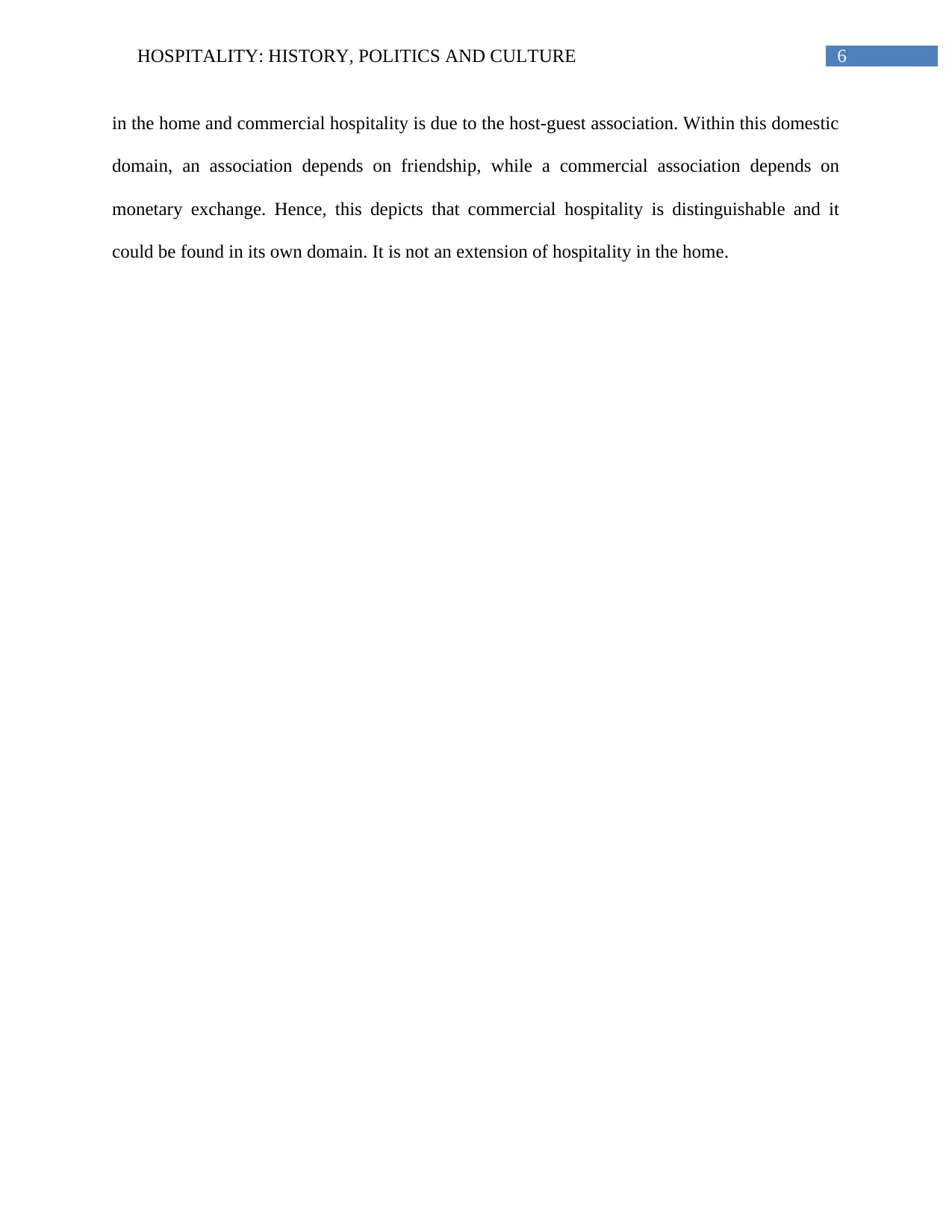
6HOSPITALITY: HISTORY, POLITICS AND CULTURE
in the home and commercial hospitality is due to the host-guest association. Within this domestic
domain, an association depends on friendship, while a commercial association depends on
monetary exchange. Hence, this depicts that commercial hospitality is distinguishable and it
could be found in its own domain. It is not an extension of hospitality in the home.
in the home and commercial hospitality is due to the host-guest association. Within this domestic
domain, an association depends on friendship, while a commercial association depends on
monetary exchange. Hence, this depicts that commercial hospitality is distinguishable and it
could be found in its own domain. It is not an extension of hospitality in the home.
Paraphrase This Document
Need a fresh take? Get an instant paraphrase of this document with our AI Paraphraser
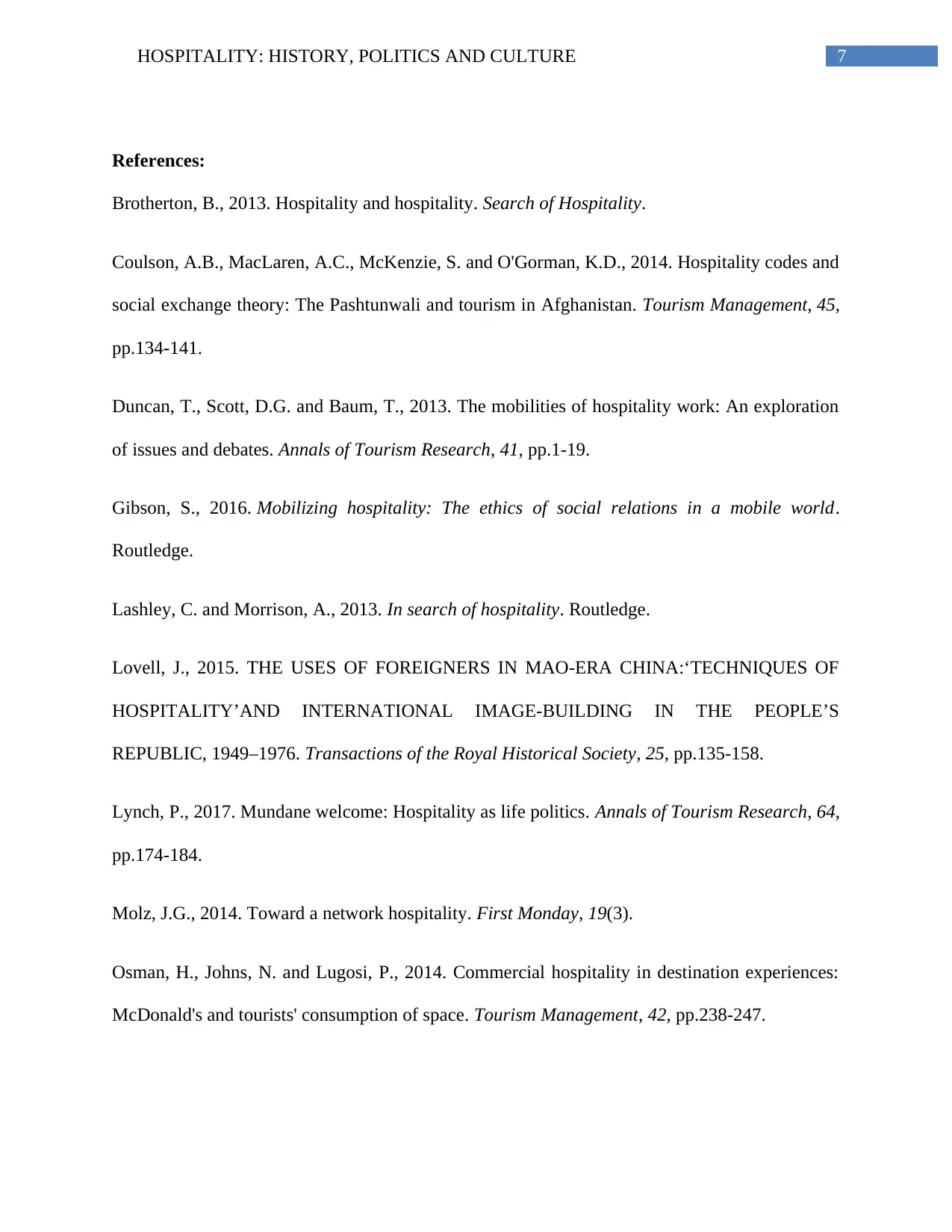
7HOSPITALITY: HISTORY, POLITICS AND CULTURE
References:
Brotherton, B., 2013. Hospitality and hospitality. Search of Hospitality.
Coulson, A.B., MacLaren, A.C., McKenzie, S. and O'Gorman, K.D., 2014. Hospitality codes and
social exchange theory: The Pashtunwali and tourism in Afghanistan. Tourism Management, 45,
pp.134-141.
Duncan, T., Scott, D.G. and Baum, T., 2013. The mobilities of hospitality work: An exploration
of issues and debates. Annals of Tourism Research, 41, pp.1-19.
Gibson, S., 2016. Mobilizing hospitality: The ethics of social relations in a mobile world.
Routledge.
Lashley, C. and Morrison, A., 2013. In search of hospitality. Routledge.
Lovell, J., 2015. THE USES OF FOREIGNERS IN MAO-ERA CHINA:‘TECHNIQUES OF
HOSPITALITY’AND INTERNATIONAL IMAGE-BUILDING IN THE PEOPLE’S
REPUBLIC, 1949–1976. Transactions of the Royal Historical Society, 25, pp.135-158.
Lynch, P., 2017. Mundane welcome: Hospitality as life politics. Annals of Tourism Research, 64,
pp.174-184.
Molz, J.G., 2014. Toward a network hospitality. First Monday, 19(3).
Osman, H., Johns, N. and Lugosi, P., 2014. Commercial hospitality in destination experiences:
McDonald's and tourists' consumption of space. Tourism Management, 42, pp.238-247.
References:
Brotherton, B., 2013. Hospitality and hospitality. Search of Hospitality.
Coulson, A.B., MacLaren, A.C., McKenzie, S. and O'Gorman, K.D., 2014. Hospitality codes and
social exchange theory: The Pashtunwali and tourism in Afghanistan. Tourism Management, 45,
pp.134-141.
Duncan, T., Scott, D.G. and Baum, T., 2013. The mobilities of hospitality work: An exploration
of issues and debates. Annals of Tourism Research, 41, pp.1-19.
Gibson, S., 2016. Mobilizing hospitality: The ethics of social relations in a mobile world.
Routledge.
Lashley, C. and Morrison, A., 2013. In search of hospitality. Routledge.
Lovell, J., 2015. THE USES OF FOREIGNERS IN MAO-ERA CHINA:‘TECHNIQUES OF
HOSPITALITY’AND INTERNATIONAL IMAGE-BUILDING IN THE PEOPLE’S
REPUBLIC, 1949–1976. Transactions of the Royal Historical Society, 25, pp.135-158.
Lynch, P., 2017. Mundane welcome: Hospitality as life politics. Annals of Tourism Research, 64,
pp.174-184.
Molz, J.G., 2014. Toward a network hospitality. First Monday, 19(3).
Osman, H., Johns, N. and Lugosi, P., 2014. Commercial hospitality in destination experiences:
McDonald's and tourists' consumption of space. Tourism Management, 42, pp.238-247.
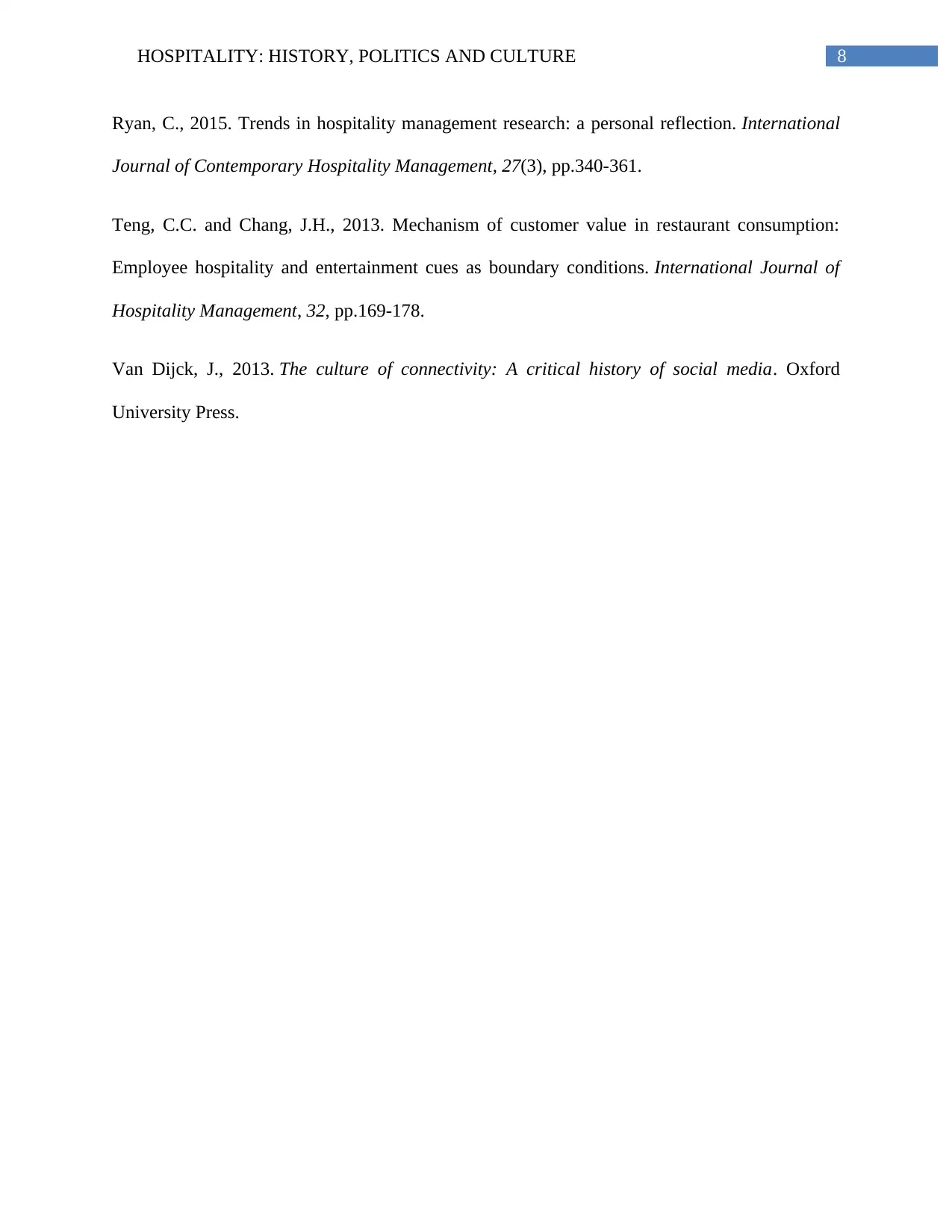
8HOSPITALITY: HISTORY, POLITICS AND CULTURE
Ryan, C., 2015. Trends in hospitality management research: a personal reflection. International
Journal of Contemporary Hospitality Management, 27(3), pp.340-361.
Teng, C.C. and Chang, J.H., 2013. Mechanism of customer value in restaurant consumption:
Employee hospitality and entertainment cues as boundary conditions. International Journal of
Hospitality Management, 32, pp.169-178.
Van Dijck, J., 2013. The culture of connectivity: A critical history of social media. Oxford
University Press.
Ryan, C., 2015. Trends in hospitality management research: a personal reflection. International
Journal of Contemporary Hospitality Management, 27(3), pp.340-361.
Teng, C.C. and Chang, J.H., 2013. Mechanism of customer value in restaurant consumption:
Employee hospitality and entertainment cues as boundary conditions. International Journal of
Hospitality Management, 32, pp.169-178.
Van Dijck, J., 2013. The culture of connectivity: A critical history of social media. Oxford
University Press.
⊘ This is a preview!⊘
Do you want full access?
Subscribe today to unlock all pages.

Trusted by 1+ million students worldwide
1 out of 9
Related Documents
Your All-in-One AI-Powered Toolkit for Academic Success.
+13062052269
info@desklib.com
Available 24*7 on WhatsApp / Email
![[object Object]](/_next/static/media/star-bottom.7253800d.svg)
Unlock your academic potential
Copyright © 2020–2025 A2Z Services. All Rights Reserved. Developed and managed by ZUCOL.





